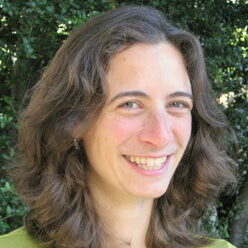Naomi S. Ginsberg
Chemist Faculty Scientist
Biography
Naomi S. Ginsberg is an Associate Professor of Chemistry and Physics at University of California, Berkeley and a Faculty Scientist in the Materials Sciences and Molecular Biophysics and Integrated Imaging Divisions at Lawrence Berkeley National Laboratory, where she has been since 2010. She currently focuses on elucidating the electronic and molecular dynamics in a wide variety of soft electronic and biological materials by devising new electron and optical imaging modalities that enable characterization of fast and ultrafast processes at the nanoscale and as a function of their heterogeneities. Naomi received a B.A.Sc. degree in Engineering Science from the University of Toronto in 2000 and a Ph.D. in Physics from Harvard University in 2007, after which she held a Glenn T. Seaborg Postdoctoral Fellowship at Lawrence Berkeley National Lab. Her background in chemistry, physics, and engineering has previously led her to observe initiating events of photosynthesis that take place in a millionth billionth of a second and to slow, stop, and store light pulses in some of the coldest atom clouds on Earth. She is the Berkeley lead of STROBE, a multi-university NSF Science and Technology Center devoted to imaging science, a member of the Kavli Energy Nanoscience Institute at Berkeley, and the recipient of a David and Lucile Packard Fellowship in Science and Engineering (2011), a DARPA Young Faculty Award (2012), an Alfred P. Sloan Foundation Fellowship (2015), and a Camille Dreyfus Teacher-Scholar Award (2016) in addition to a series of teaching awards in the physical sciences. In 2017-18 she was a Miller Professor for Basic Research in Science at UC Berkeley and was designated a Kavli Fellow.
Research Interests
We are pushing the limits of spatially resolved spectroscopy and time resolved microscopy in multiple modalities, tailored to answer fundamental and challenging questions that span chemistry, physics, and biology.
- How can we investigate the optical properties of soft matter and biological systems well below the diffraction limit? Can the nanoscale dynamics of both matter and energy in these systems be studied non-invasively in real-time?
- How does the local morphology of organic electronics affect their exciton dynamics? What is the relationship between local electron dynamics and overall device performance?
- How can we learn from the remarkable efficiency of photosynthesis to guide the design and optimization of biomimetic light harvesting systems? How can energy flow be manipulated?
A common theme in our work is to investigate light-matter interactions in the near- and far-field, on ultrafast time scales, with light and electron optics, in vacuum and in the condensed phase. Please consult the Research page for additional detail.
Recent Publications
Related News
Young Biosciences Researchers Rub Elbows with Nobel Company
MBIB graduate students Margaret Doyle and Christian Tanner were among 27 highly accomplished young UC scientists selected as fellows to the prestigious 2024 Lindau Nobel Nobel Laureate Meeting in Germany where they mingled with Nobel laureates.
Naomi Ginsberg Elected Fellow of the American Physical Society
Naomi Ginsberg, a faculty scientist in the Molecular Biophysics and Integrated Bioimaging (MBIB) Division, is among the 2021 class of Fellows elected by the American Physical Society (APS). The APS Fellowship Program recognizes members who have made exceptional contributions to the physics enterprise in research, applications, leadership, service, or education. Ginsberg, who is also a UC Berkeley associate professor of chemistry, was cited for her innovative development of spatiotemporally resolved imaging and spectroscopy methods—as well as their applications in elucidating energy transport in hierarchical and heterogeneous materials and in the formation and transformation of said materials.
Tracking Energy Flow in Light-harvesting Systems on Native Nanometer and Picosecond Scales
In the first trillionths of a second after sunlight hits a photosynthetic organism, the energy that is absorbed flows through a dense network of protein-bound chlorophyll molecules to a dedicated location where it is converted to electric charges. This is the first step in a series of events that ultimately drives the formation of sugar and starch to store energy in chemical bonds. “This migration is the triggering event that leads to all of the oxygen that we breathe, all of the food that we have, and we really don’t understand why this part of photosynthesis works as well as it does. For every photon of light that’s absorbed, you can expect some biochemical action to occur. That efficiency is really remarkable,” says Naomi Ginsberg, a faculty scientist in the Molecular Biophysics and Integrated Bioimaging (MBIB) Division who has a secondary affiliation in Materials Sciences and is also a UC Berkeley associate professor of Chemistry and Physics. Ginsberg and her colleagues devised a way to measure migration efficiency, and they describe the method in Nature Materials in November 2017.




